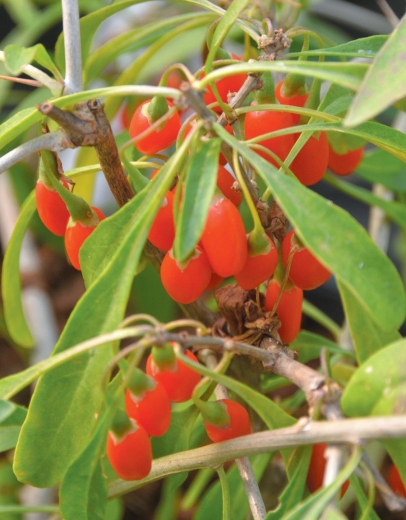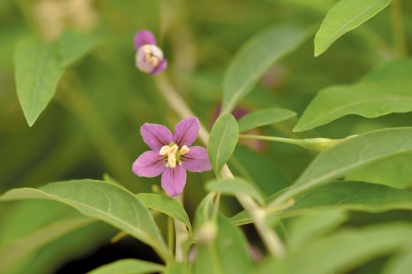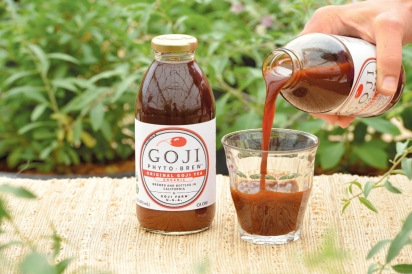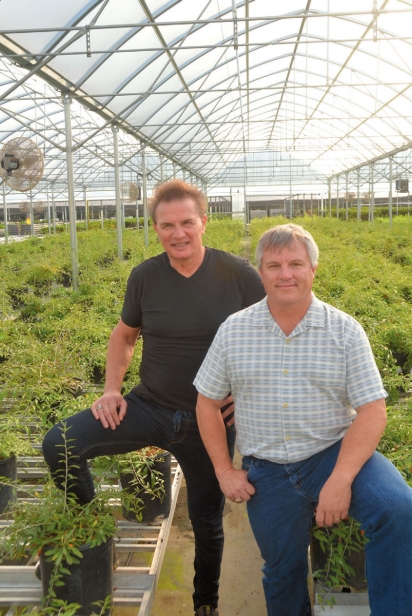Goji Farm USA Brings Superfruit to Sonoma County
There’s a New Brew in Town
Despite the moniker, Northern California Wine Country is certainly known for more than wine: craft brewing, artisan cheesemaking, world-class baking and specialty vegetable production, to mention only a few thriving local industries.
The region has also long been a leader in the health and “functional” food category. This past fall, a brand new crop had its coming out party in Sonoma County, highlighting a confluence of functional food and agriculture.
The party celebrated the harvest of Goji Farm USA’s 8,000 goji plants growing in Sonoma’s Valley of the Moon region. The goji berry, Lycium barbarum—also known as Chinese Wolfberry—would be familiar to most people as a dried fruit, reddish-brown in color and about the size of a raisin. The harvest event at Goji Farm USA was for most attendees their first opportunity to see and taste fresh goji berries.
Goji berries are famous for their high levels of antioxidants and vitamins. For centuries they have been used in Chinese medicine and cuisine to support healthy aging and, specifically, vision, kidney and liver functions. Modern research into the nutritional benefits of goji berries is providing scientific support for the centuries of anecdotal evidence and traditional use. The oxygen radical absorbance capacity (ORAC) value—a measure of antioxidant activity in biological samples in vitro—of goji is higher than that of blueberries and even pomegranates.
The plants at Goji Farm USA are being grown in a 46,000-square-foot greenhouse on the campus of Novavine, a well-known producer of grapevines located in Santa Rosa. How these prickly upstarts came to share a greenhouse with wine grape royalty like Cabernet Sauvignon 191 and the Swan clone of Pinot Noir is one of those stories that it is hard to imagine coming together any place but Northern California.
Goji Farm USA is the brainchild of Tibor Fischl of Santa Rosa. The genesis of the idea goes back over a decade to Fischl’s work in renewable energy. He was developing several large agricultural projects in the Salinas Valley when the recession of 2007 and permit issues halted the work. Although none of those projects moved ahead, the notion that there was a place for innovation in agricultural applications of renewable energy stuck with him and he began investigating potential crops for the North Bay area that would be suitable for a sustainable greenhouse production system.
While evaluating the market potential and agricultural feasibility of various crops, Fischl’s longtime interest in health and athletics drew him to consider a number of high-nutrient plants, including acai, moringa and blueberries. In addition to the growing of the crop, he wanted to create a vertically integrated company, so he needed a consumer-facing product as well. The fruit that brought it all together for him was the goji berry, and a beverage that would become Goji Phyto-Brew.
Fischl’s search for stateside-grown goji plants led him to a man in Utah and a fascinating bit of American history. The late Donald Daugs was hunting deer in the fall of 2004 when he noticed some red berries growing on a friend’s ranch. He recognized them as goji. His friend didn’t know what they were, or how they came to be on his ranch, so Daugs dug a little deeper.
Just south of the ranch was the location of one of the largest Chinese worker camps during the construction of the transcontinental railroad. This proximity suggested that the plants growing in Utah in 2004 were likely the descendants of goji plants brought from China and grown by railroad workers in the mid 18th century. DNA analysis of the Utah goji supports an origin of Ningxia, China. These hardy goji plants provided the mother stock for Daugs’s Phoenix Tears Nursery in Cache Valley, Utah. It was from Daugs that Tibor Fischl acquired the original 644 bareroot goji he planted in Sonoma County.
The key person on the farming side of Goji Farm USA entered the picture in 2014. Jay Jensen, CEO of Novavine, was initially intrigued by the idea of growing goji and the potential of Fischl’s beverage, but his decision to get involved was also motivated by agricultural practicalities. The primary business of Novavine is producing grafted grapevines for the premium wine industry. Like most agricultural products, this business is seasonal, alternating periods of intense activity with periods of quiet. Jensen is always looking for ways to utilize his facilities and labor force during those down times. Olive trees were already part of this alternate-season cycle, and he saw goji berries as another interesting and unique crop to add to his rotation.
Fischl’s original plants from Utah came to live at the nursery where they provided cuttings to grow additional plants. Goji can be grown from seed, but at Novavine they are vegetatively propagated. Goji plants are vigorous and hardy, but that does not necessarily translate into “easy to grow,” as any gardener who has ever killed a “tough” California native plant knows.
The team’s original concept was to grow the goji plants in the greenhouse and create four crop cycles per year. The first year of production showed that four harvests would not be possible because the plants required winter chill and dormancy for fruiting. It was also discovered that they are susceptible to powdery mildew and need to be managed very carefully in the greenhouse environment. The lessons learned have resulted in an indoor/outdoor rotation, and three crops of goji berries per year.
Jensen is open about the learning curve, noting that they continue to actively experiment to figure out the best way to grow and manage the plants. In this spirit, some goji have been planted outside of the greenhouse to see how they do in the great outdoors of Sonoma Valley.
Adding to the production challenge is their newly acquired organic status for three of the nursery greenhouses that will be used for Certified Organic production of goji berries.
All that said, the most challenging part of the process is not growing the berries, it is picking them. As visitors to the harvest event saw, collecting the fruit is slow work. The plants have thorns, and the older the wood the thornier it gets. In China, goji typically grow to six feet and are pruned back to a permanent woody structure. At Goji Farm USA they are experimenting with keeping the plants small and pruning them hard. The first-year wood is very productive—as well as less thorny—so the hope is that this high productivity will balance out the smaller size of the plants. The goal is to eventually pick about 20 pounds per year from each of the plants, in three harvests.
So the berries are good for you, but how do they taste? Lycium barbarum berries are in the Solanaceae or nightshade family, and share some culinary characteristics with their cousin the tomato. Eaten fresh, the berries are a little sweeter than a tomato but have a flavor that shows the kinship.
When asked about the timeline for Goji Farm USA’s fresh goji berries being made available to consumers, Jensen was cautious. He pointed out that they are a very delicate crop and need special handling, making local chefs and restaurants more likely first customers. The company’s production is not even at that level currently. In the meantime, local gardeners can try growing their own goji berries; Novavine sells the plants through their NovaBackyard division.
The product from Goji Farm USA that is making its way into the wider world is their performance beverage Goji Phyto-Brew. This drink is made with imported organic dried goji berries from China and now contains some domestic goji as well. As the production of the farm increases, a beverage containing only the domestic goji is on the horizon. The Goji Farm USA website contains numerous testimonials from devotees of Goji Phyto-Brew, especially endurance athletes. The drink is currently available in retail outlets in Northern and Southern California and through the company’s website, GojiFarmUSA.com.
In addition to the berries, the leaves of the goji are extremely high in vitamins and phytonutrients. The flavor of the leaves is pleasant and delicate; it is easy to imagine them in a salad or in a pesto topping for mild fish.
With increasing interest in real foods that have health benefits, the nutrient-dense goji berry seems like a natural. While Goji Phyto-Brew gains fans in the market at large, locals in the North Bay will hopefully have a chance to try the fresh locally grown goji berries or leaves in the near future, so stay tuned for that.
Goji Farm USA is the brainchild of Tibor Fischl of Santa Rosa. The genesis of the idea goes back over a decade to Fischl’s work in renewable energy. He was developing several large agricultural projects in the Salinas Valley when the recession of 2007 and permit issues halted the work. Although none of those projects moved ahead, the notion that there was a place for innovation in agricultural applications of renewable energy stuck with him and he began investigating potential crops for the North Bay area that would be suitable for a sustainable greenhouse production system.
While evaluating the market potential and agricultural feasibility of various crops, Fischl’s longtime interest in health and athletics drew him to consider a number of high-nutrient plants, including acai, moringa and blueberries. In addition to the growing of the crop, he wanted to create a vertically integrated company, so he needed a consumer-facing product as well. The fruit that brought it all together for him was the goji berry, and a beverage that would become Goji Phyto-Brew.
Fischl’s search for stateside-grown goji plants led him to a man in Utah and a fascinating bit of American history. The late Donald Daugs was hunting deer in the fall of 2004 when he noticed some red berries growing on a friend’s ranch. He recognized them as goji. His friend didn’t know what they were, or how they came to be on his ranch, so Daugs dug a little deeper.
Just south of the ranch was the location of one of the largest Chinese worker camps during the construction of the transcontinental railroad. This proximity suggested that the plants growing in Utah in 2004 were likely the descendants of goji plants brought from China and grown by railroad workers in the mid 18th century. DNA analysis of the Utah goji supports an origin of Ningxia, China. These hardy goji plants provided the mother stock for Daugs’s Phoenix Tears Nursery in Cache Valley, Utah. It was from Daugs that Tibor Fischl acquired the original 644 bareroot goji he planted in Sonoma County.
The key person on the farming side of Goji Farm USA entered the picture in 2014. Jay Jensen, CEO of Novavine, was initially intrigued by the idea of growing goji and the potential of Fischl’s beverage, but his decision to get involved was also motivated by agricultural practicalities. The primary business of Novavine is producing grafted grapevines for the premium wine industry. Like most agricultural products, this business is seasonal, alternating periods of intense activity with periods of quiet. Jensen is always looking for ways to utilize his facilities and labor force during those down times. Olive trees were already part of this alternate-season cycle, and he saw goji berries as another interesting and unique crop to add to his rotation.
Fischl’s original plants from Utah came to live at the nursery where they provided cuttings to grow additional plants. Goji can be grown from seed, but at Novavine they are vegetatively propagated. Goji plants are vigorous and hardy, but that does not necessarily translate into “easy to grow,” as any gardener who has ever killed a “tough” California native plant knows.
The team’s original concept was to grow the goji plants in the greenhouse and create four crop cycles per year. The first year of production showed that four harvests would not be possible because the plants required winter chill and dormancy for fruiting. It was also discovered that they are susceptible to powdery mildew and need to be managed very carefully in the greenhouse environment. The lessons learned have resulted in an indoor/outdoor rotation, and three crops of goji berries per year.
Jensen is open about the learning curve, noting that they continue to actively experiment to figure out the best way to grow and manage the plants. In this spirit, some goji have been planted outside of the greenhouse to see how they do in the great outdoors of Sonoma Valley.
Adding to the production challenge is their newly acquired organic status for three of the nursery greenhouses that will be used for Certified Organic production of goji berries.
All that said, the most challenging part of the process is not growing the berries, it is picking them. As visitors to the harvest event saw, collecting the fruit is slow work. The plants have thorns, and the older the wood the thornier it gets. In China, goji typically grow to six feet and are pruned back to a permanent woody structure. At Goji Farm USA they are experimenting with keeping the plants small and pruning them hard. The first-year wood is very productive—as well as less thorny—so the hope is that this high productivity will balance out the smaller size of the plants. The goal is to eventually pick about 20 pounds per year from each of the plants, in three harvests.
So the berries are good for you, but how do they taste? Lycium barbarum berries are in the Solanaceae or nightshade family, and share some culinary characteristics with their cousin the tomato. Eaten fresh, the berries are a little sweeter than a tomato but have a flavor that shows the kinship.
When asked about the timeline for Goji Farm USA’s fresh goji berries being made available to consumers, Jensen was cautious. He pointed out that they are a very delicate crop and need special handling, making local chefs and restaurants more likely first customers. The company’s production is not even at that level currently. In the meantime, local gardeners can try growing their own goji berries; Novavine sells the plants through their NovaBackyard division.
The product from Goji Farm USA that is making its way into the wider world is their performance beverage Goji Phyto-Brew. This drink is made with imported organic dried goji berries from China and now contains some domestic goji as well. As the production of the farm increases, a beverage containing only the domestic goji is on the horizon. The Goji Farm USA website contains numerous testimonials from devotees of Goji Phyto-Brew, especially endurance athletes. The drink is currently available in retail outlets in Northern and Southern California and through the company’s website, GojiFarmUSA.com.
In addition to the berries, the leaves of the goji are extremely high in vitamins and phytonutrients. The flavor of the leaves is pleasant and delicate; it is easy to imagine them in a salad or in a pesto topping for mild fish.
With increasing interest in real foods that have health benefits, the nutrient-dense goji berry seems like a natural. While Goji Phyto-Brew gains fans in the market at large, locals in the North Bay will hopefully have a chance to try the fresh locally grown goji berries or leaves in the near future, so stay tuned for that.








